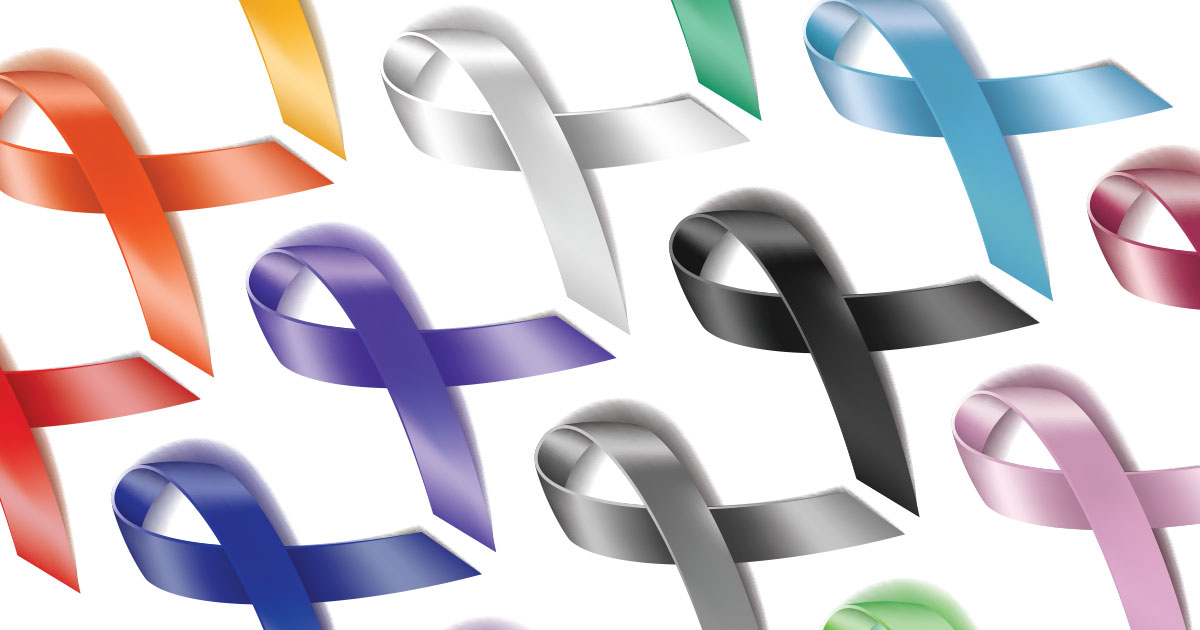We all have seen them at one time or another: awareness ribbons of different colors, representing various causes. According to the website Disabled World Towards Tomorrow, awareness ribbons are “short pieces of colored ribbon folded into a loop and are used in the United States, Canada, Australia, UK, and other parts of the world.” These ribbons are used to show your support for a certain cause or issue. A single color can have multiple meanings, and some can have patterns. Also, a cause or issue can have more than one color. There is no exact number as to how many awareness ribbons exist because they are universally-used. Some of the well-known colors include pink for breast cancer, red for AIDS, and purple for Alzheimer’s. But, do you know what the lesser known colors support? Let’s take a look below.
- Black is used as a sign of mourning for those lost in the 9/11 attacks and the Virginia Tech massacre. Also, black is associated with melanoma awareness, narcolepsy, and sleep disorders.
- Blue awareness ribbons have many meanings, including addiction recovery awareness, bullying, colon cancer, foster care awareness, Huntington’s disease, and the West Nile virus. Light blue ribbons stand for Addison’s disease, prostate cancer, and lymphedema. As for navy blue, this color brings awareness to Crohn’s disease, rectal cancer, colon cancer, and colorectal cancers. Robin’s egg blue represents Pierre Robin syndrome, and pale blue is achalasia awareness. Lastly, royal blue stands for child abuse awareness. A mixed blue and gray ribbon with a red drop means awareness for type 1 diabetes.
- Brown is an alternate color for colon cancer and colorectal cancers, but it also stands for anti-tobacco.
- Burgundy has a few different meanings, including adults with disabilities, meningitis, sickle cell anemia, and headaches and migraines.
- Brain tumors and brain cancer are supported through gray ribbons. Also, diabetes and asthma awareness use this color.
- There are a few shades of green that symbolize various causes. Your regular shade of green gives awareness to bipolar disorder, childhood depression, cerebral palsy, depression, mental health, mental illness, and kidney cancer. A lime green ribbon is used for Lyme disease, muscular dystrophy, and lymphoma. Addiction recovery, bone tumor awareness, and renal cell carcinoma are supported by turquoise ribbons. Another commonly known awareness ribbon is the color teal. This shade represents anti-bullying, anxiety disorder, cervical cancer, ovarian cancer, and other gynecological cancers, polycystic ovarian syndrome, food allergies, post-traumatic stress disorder, and sexual assault and sexual violence awareness.
- Yellow awareness ribbons mean bladder cancer, endometriosis awareness, liver cancer and liver disease, missing children, and suicide prevention.
- Gold awareness ribbons are another popular color and many people know their meanings. Childhood cancers and neuroblastoma and osteosarcoma are represented by this color.
- Orange brings awareness to attention deficit hyperactivity disorder (ADHD), COPD, leukemia, lupus, multiple sclerosis, and kidney cancer.
- Pearl, white and clear ribbons stand for dating violence awareness, lung cancer and lung disease, emphysema, bone cancer, postpartum depression, and scoliosis.
- Pink is very well-known for breast cancer, but it also gives awareness to birth parents and nursing mothers.
- Many people associate purple awareness ribbons with Alzheimer’s Disease, but that isn’t the only thing they’re known for. This color is used for ADD, ADHD, cystic fibrosis, domestic violence, epilepsy, March of Dimes, pancreatic cancer, and thyroid cancer. Shades of purple, such as lavender and periwinkle draw awareness to all types of cancer awareness, gynecological cancers, eating disorders, and gastric cancer.
- Red awareness ribbons support AIDS and HIV, congenital heart defects and disease, heart disease, stroke awareness, and tuberculosis.
- Last, but not least, brain disorders, dyslexia, Parkinson’s disease, and schizophrenia are given awareness through the color silver.
Symbols and patterns are also used in various awareness ribbons. These symbols include the autism infinity symbol, blue star, blue diabetes circle, and butterflies for Turner syndrome and Beckwith-Wiedemann Syndrome.
If you are like me, you have always wondered what a certain color of ribbon meant. Well, now you know and can easily see what causes have special meanings to different people.



















